Though height doesn’t mean much to me, it is hard not to be elevated by the stature of the tulip tree.
In his short story The Gold-Bug, Edgar Allan Poe acknowledged the tree’s lofty nature and impressive appearance. He described one specimen as “an enormously tall tulip-tree, which stood, with some eight or ten oaks, upon the level, and far surpassed them all, and all other trees which I had then ever seen, in the beauty of its foliage and form, in the wide spread of its branches, and in the general majesty of its appearance.”
Tulip trees at their biggest are reputed to reach almost 200 feet, giving them the title of tallest eastern native hardwood tree. Even on the Vineyard, this species holds its own. A tulip tree at The Polly Hill Arboretum reaches over a hundred feet up to the sky and is celebrated as the tallest tree on its grounds. That individual tree is one of a limited number that tower over our Island.
Last week, on Pennacook avenue in Oak Bluffs, I spent an evening admiring a blooming tulip tree from a friend’s porch. It wasn’t its size that got my attention but rather its flowers, which were substantial in number, bulk, and beauty. The tree was completely leafed out and covered with large yellow-green blossoms and a splashing stripe of orange. Not surprisingly, these large flowers delight bees and provide well for them (and us), with one 20-year-old tree reportedly able to yield enough nectar to produce four pounds of honey.
Also called tulip wood, tulip poplar, fiddletree, lily tree, white wood, canoe wood, and saddle-leaf tree, the tulip tree, while native to the eastern United States, finds its northernmost range in Rhode Island and some parts of Massachusetts. It is more prevalent in many other places in the state because of its popularity as an ornamental shade and street tree.
All of its names are suggestive of the plant’s features and uses. Indigenous people valued its straight trunk for canoes and Daniel Boone followed their lead, building one to carry his family west. Its leaves and, some say, flowers look like tulips; however, the tulip tree is not related to tulips, poplars, or lilies. A member of the magnolia family, it is one of two species represented by its genus, liriodendron.
Medicinal and even very limited edible uses such as drinking its nectar round out the accolades given to tulip trees. Wildlife adore and enjoy this native tree turned domestic diva. Pollinators appreciate its copious nectar, eastern swallowtail butterflies lay their eggs and rear caterpillars on its leaves and birds eat its seeds, as do small mammals such as mice, rabbits and squirrels. The latter also tear its twigs to drink sap. It is no surprise that Jacob Bigelow, Massachusetts botanist and founder of Mount Auburn Cemetery, was very enthusiastic, proclaiming tulip trees “One of the noblest trees, both in size and beauty, of the American forest.”
A more local tale of the tulip tree came from novelist Nicole Galland, writing in Martha’s Vineyard Magazine some years ago. She described the meticulous planting and care of 150 tulip trees in West Tisbury. It all ended in disaster when the baby trees were inadvertently killed by being sprayed with herbicides instead of insecticides. Perhaps her vision was to tiptoe through the tulips someday but that dream (and her trees) didn’t take root.
Suzan Bellincampi is director of Felix Neck Wildlife Sanctuary in Edgartown and the Nantucket Wildlife Sanctuaries. She is also the author of Martha’s Vineyard: A Field Guide to Island Nature and The Nature of Martha’s Vineyard.




Comments
Comment policy »